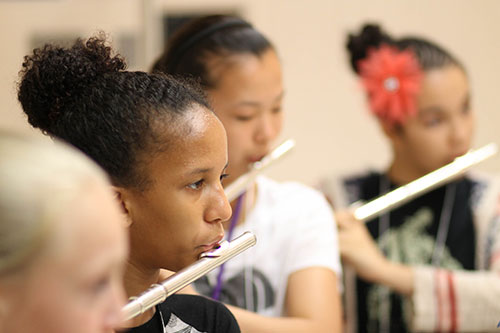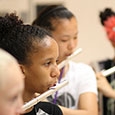
photo courtesy of Athena Music Camp
After opening a private flute studio, I found myself repeating to each of 20 students the same basic suggestions about posture, finger placement, breathing and other essentials of good flute playing. Many flute students were bored with the school music program because the director devoted so much time to the other instruments that the opportunities to play were limited. Some flutists complained they couldn’t hear their flute because everyone else was so loud.
As summer approached I feared some students would become distracted and lose interest in practicing without band performances and rehearsals. As an alternative to group lessons, I formed a flute ensemble. It would give them the opportunity to work on the problems that had appeared in so many lessons. The group was big enough to give students a sense of collegiality but small enough that each person made an identifiable contribution.
The ensemble first met on the last day of school and continued throughout the summer, meeting every other Saturday for two hours. After six rehearsals they performed a recital and clearly enjoyed having accomplished so much in a short time period. We decided not to continue rehearsals during the school year to keep the experience fresh for summer.
The goal was to have fun and to learn while playing both familiar and new music. Students were encouraged to ask others for help and, in tum to help anyone who had questions. Most members were middle school students of about the same ability level. Two advanced high school students provided leadership, and two advanced elementary students also joined the group. While a little competition can be good, too much of it can undercut self-esteem or cause hard feelings. To promote a friendly and inviting atmosphere, the last 15 minutes of each rehearsal were reserved for refreshments and conversation, so members could make new friends and talk about hobbies.
We spent considerable time tuning at the beginning and throughout each rehearsal. Warm-ups were scales, rhythms, whole-note, and half-note exercises on thirds, fifths, and octaves. We played one more scale in whole notes, both with and without a tuner. Students helped each other correct pitch problems, including suggestions to keep the head up, use more air, and pull the headjoint out. Midway through a rehearsal or for a particularly difficult passage we checked the intonation by holding each note of the passage and listening for the intervals.
During warm-ups we discussed the basics of posture and breathing as they affect intonation. We also used a set of rhythm exercises that started simply but moved on to difficult rhythms in the repertoire.
I tried to include diverse styles of music that would appeal to students. One program consisted of "Dance of the Flutes" by Tchaikovsky; "Musette" by J.S. Bach; "Menuette Classique" from The Art and Practice of Modern Flute Technique, Book Two, by William Kincaid; "Rondo" by Jean Joseph Mouret, arranged by Sondra Tucker; and "Shenandoah" arranged by Sondra Tucker. Each of these short selections has musical challenges. Students instantly liked the easy "Musette" and "Menuette," for which we focused on fundamentals and discussed the importance of moving lines and melody. The Rondo was more challenging, but again well loved. "Shenandoah" proved to be the most difficult piece, but as we struggled to learn and balance the parts it became our favorite. All of the students were familiar with "Dance of the Flutes" and excited about playing it. The 32nd notes motivated diligent work on scales and arpeggios and the piece was a perfect conclusion to the recital program.
Most arrangements were for three or four flutes, which meant two or three players to every part. The music called for students to be strong, but no one was ever alone on a part. We switched parts on every composition so everyone played first flute on at least one piece.
Intonation steadily improved, which was gratifying to them because it is sometimes neglected in private lessons as students struggle with notes. So often in school bands they could not hear well enough to check intonation let alone make adjustments. In a flute ensemble they could readily hear if someone was out of tune.
Everyone had a good time and made new friends in an atmosphere that was not burdened by competition.





